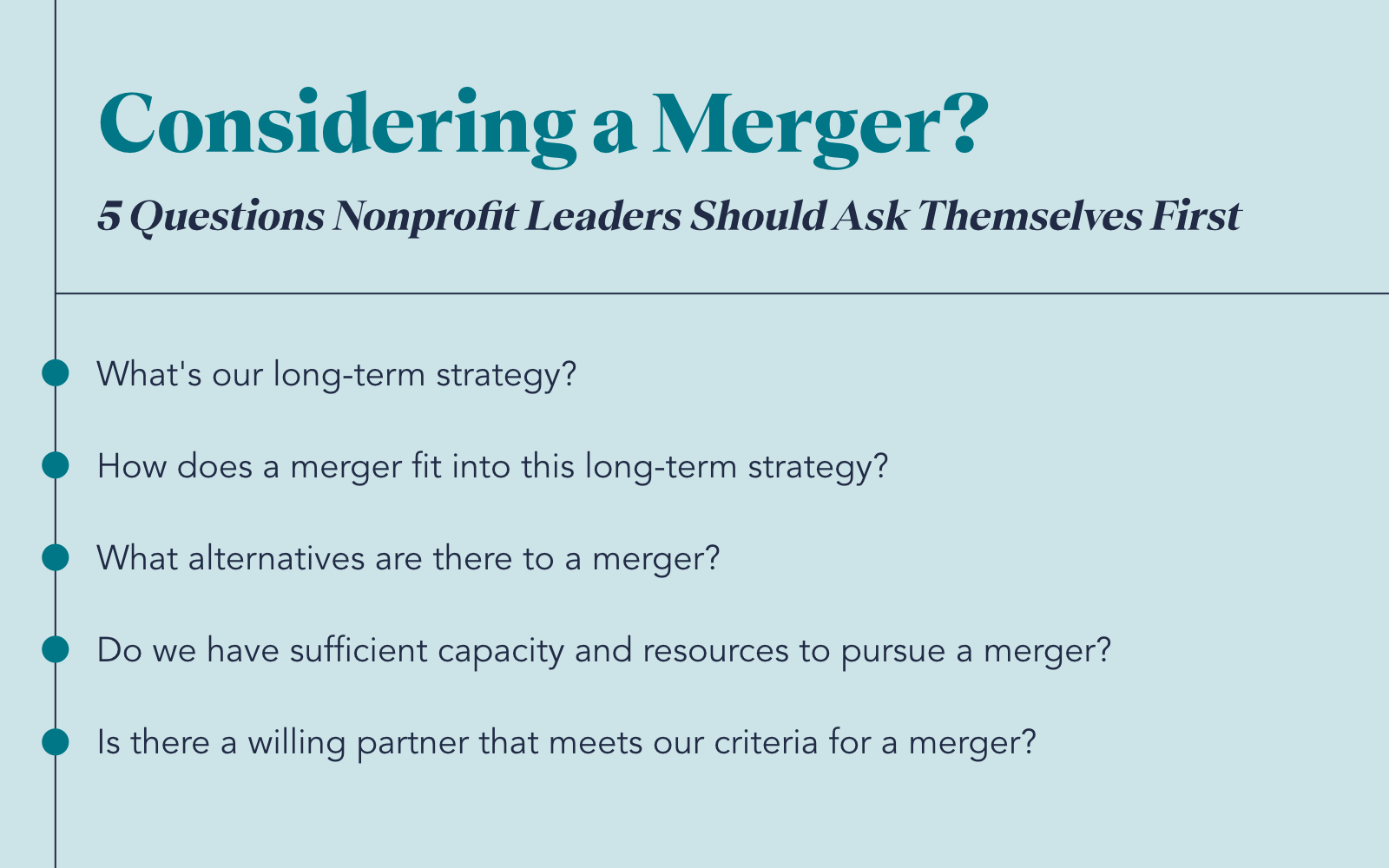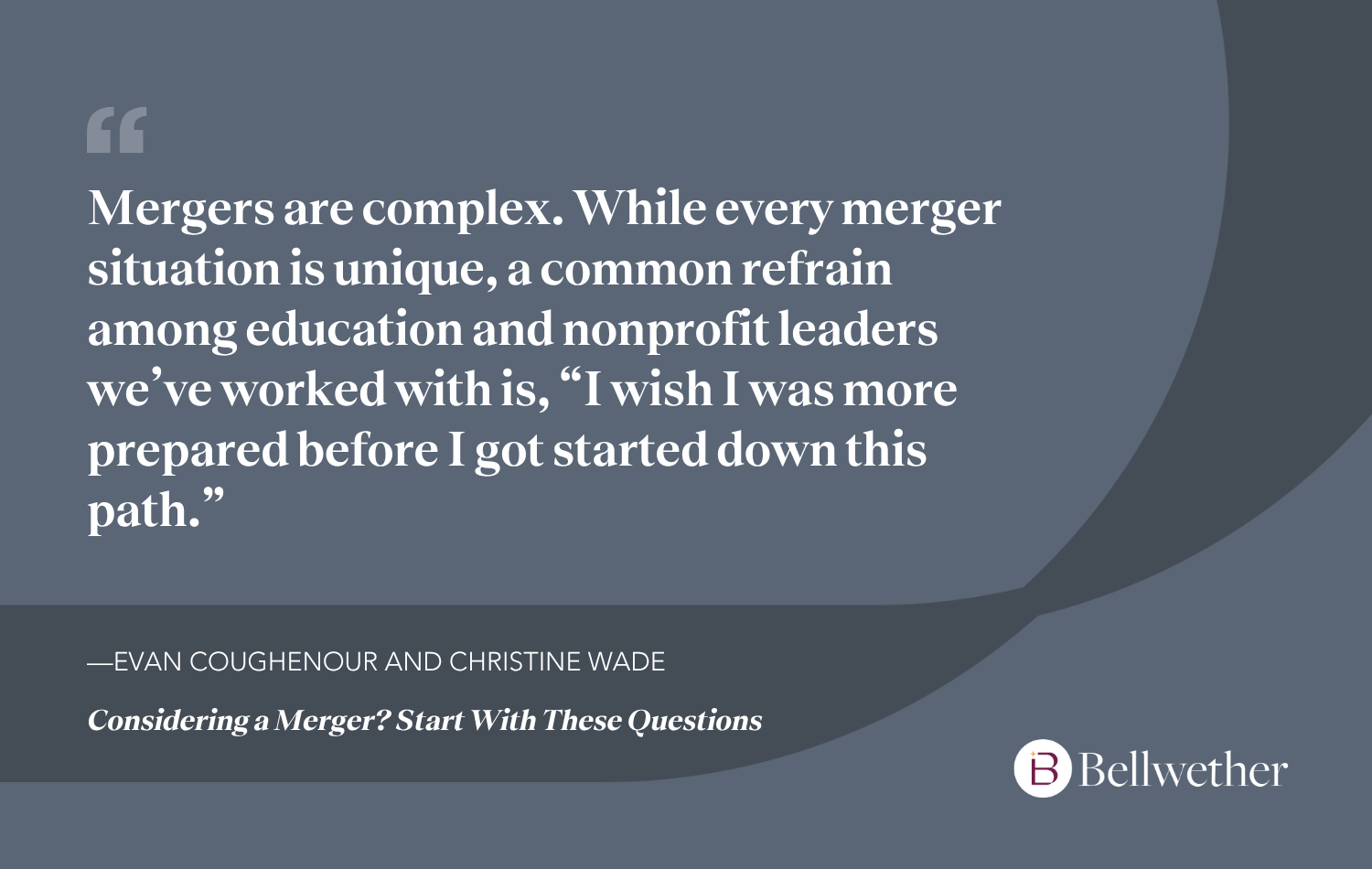Interested in learning more? Watch our webinar answering common questions featuring Evan Coughenour and Christine Wade.
Declining K-12 enrollment and federal policy changes have led to increased competition for funds, talent, and students in the K-12 education sector. As a result, a growing number of nonprofit, school, and district leaders are turning to mergers as a strategic pathway to achieving their organizational goals, a trend we anticipate continuing in the coming years.
Mergers are complex. While every merger situation is unique, a common refrain among education and nonprofit leaders we’ve worked with is, “I wish I was more prepared before I got started down this path.” Leaders and boards can avoid wasted time and effort and increase their odds of a successful strategic partnership by doing some critical reflection and asking themselves a set of focused questions prior to diving into a merger exploration process.

“What’s our long-term strategy?”
Leaders first need to reground themselves in their organization’s long-term vision, mission, and strategic goals. Whether it’s being an A-rated school, moving 1,000 families into supportive housing, or improving career outcomes for local young people, anchoring in the core DNA of their organization can help leaders choose their moves wisely. Answering these questions first helps leaders see what they need to do to achieve their goals and then decide whether and how a merger might fit in.
- Vision and mission: What outcomes does the organization hope to achieve and over what time frame (e.g., number of people impacted, influence on broader field)?
- Current state: How close or far is the organization from achieving those outcomes?
- Landscape: What opportunities or challenges is the organization facing?
- Path forward: In light of the above, what steps are necessary to achieve the organization’s vision and mission?
“How does a merger fit into this overall organizational strategy?”
With a long-term strategy in place, leaders must consider how a merger can accelerate or detract from progress. When done effectively, mergers can be a strategic tool for partnering organizations to:
- Increase the scale of impact, expanding the amount of individuals they can serve.
- Increase revenue, allowing for more resources or more diverse funding opportunities.
- Save money by reducing overhead costs, freeing up dollars for program delivery and innovation.
- Secure new leadership (especially during periods of transition) by merging with an organization with a strong executive director and/or CEO at the helm.
- Attract or retain top talent by opening up opportunities for leadership or career advancement.
“What alternatives are there to a merger?”
A merger is rarely the only or easiest way to achieve the above goals, so leaders and boards should consider all pathways carefully before making any formal commitments. Organizations may be able to achieve their goals without merging by:
- Cost-sharing for specific expenses (e.g., staff, equipment, facilities) without combining operations or governance.
- Sharing or contracting services — such as information technology, human resources, or accounting — to reduce costs and improve efficiency.
- Forming formal partnerships to achieve shared objectives through strategic alliances, affiliations, or jointly-run ventures.
Leaders may decide that these alternatives aren’t sufficient to meet their strategic goals — in which case a formal merger may be the most effective way to do so.
“Do we have sufficient capacity and resources to pursue a merger? Is outside expertise needed?”
Mergers are time-consuming and resource-intensive for both leaders and boards, and often distract staff from their everyday mission-driven work responsibilities. Even if leaders decide that merging with another organization is the right way to achieve organizational goals, they should still consider whether their budget, timeline, and staff capacity are sufficient to successfully explore and execute a merger. Relevant resources and capacities include:
- Leadership bandwidth: Senior leaders and board members are integral to the exploration, decision-making, and implementation of a merger, and they must be able to devote a substantial amount of time to the process.
- Timeline: From initial exploration to realizing results, the merger process can take years. Organizations must be in it for the long haul and willing to ensure that competing priorities don’t further delay the merger process.
- Legal: Organizations must complete due diligence, submit to regulatory authorities, and sometimes jump through political hoops to formalize a merger. They should retain (and pay for!) legal counsel throughout the merger process — and they need stamina to endure any curve balls that get thrown their way.
- Cost: Legal costs aren’t the only financial factor in a merger. There are many other expenses, from covering additional staff time and one-time investments to support integration to hiring external experts like accountants, strategic advisors, regulatory specialists, and communication professionals. Leaders may also need to think about their current and future funder relationships and whether philanthropy can offset some of these costs.
- Change management: Merging organizations is an investment for staff and community members, too. Leaders shouldn’t overestimate the emotional toll and amount of time it takes to bring stakeholders along, and they must anticipate pushback and the loss of key talent amid a protracted integration process.
“Is there a willing partner that meets our criteria for a merger?”
Once leaders have assessed the challenging aspects of mergers and are prepared to face them, their last step is to figure out what the landscape of prospective partners looks like. No merger can succeed without a fitting and willing partner. Whether leaders have had formal conversations with counterparts about potential partnerships or are just starting to think about prospective “good-fit” organizations, they can refine their lists by deciding on their nonnegotiable criteria. Examples of partnership criteria might include:
- Mission alignment: Leaders should target organizations with compatible visions, missions, and values. Without this alignment, it’s unlikely a merger will be successful in the long term.
- Organizational health: Leaders should carefully evaluate the operational, financial, and programmatic viability of a potential partner to ensure future sustainability.
- Size: Leaders should decide if they want to merge with a larger, smaller, or similarly-sized organization, particularly if scaling is central to achieving their goals.
- Location: Leaders must pinpoint the general location of a prospective partnering organization and determine whether they’re looking to expand geographically or double down on work within a community.
- Corporate structure and tax status(es): Leaders must take note of the legal and governance structure of potential partners, as well as their tax status. For example, it’s vital to consider the complexity of merging a 501(c)(3) with a 501(c)(4).
*
What’s next? If the answers to a majority of these questions suggest a merger as the best strategic path forward, it’s a sign to continue proactively pursuing the process by having conversations with potential partners and entering into a dedicated “exploration” phase with one or more of them. This may eventually lead to an agreement to merge and tasks that follow.
However, more likely than not, careful consideration of these initial strategic questions may prompt uncertainty or hesitation. If this is the case, leaders and board members should not abandon the pursuit of a merger entirely, but rather discuss what would need to be true for them to feel comfortable moving forward. This might mean learning more about strategic partnerships through articles or conversations with experts; conducting a broader market scan for potential partners that better meet the organization’s merger criteria; and/or revisiting these questions in 6-12 months as part of an annual or multi-year strategic planning process.
Regardless of whether an education organization decides to pursue a merger or not, considering these questions up front is time well spent: It’s wise for all organizations to have a clear perspective on their long-term goals and potential paths to achieve them. With answers to the above questions, nonprofits are better positioned to explore strategic partnerships and/or mergers, all while navigating an uncertain and challenging nonprofit landscape.
You can contact Evan Coughenour at evan.coughenour@bellwether.org or Christine Wade at christine.wade@bellwether.org to learn more about our work.
